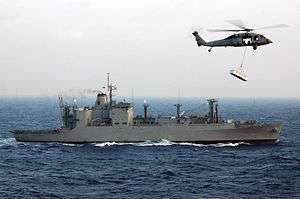USS Flint (AE-32)
 | |
| History | |
|---|---|
| Name: | USS Flint |
| Awarded: | 8 March 1968 |
| Builder: | Ingalls Shipbuilding |
| Laid down: | 4 August 1969 |
| Launched: | 9 November 1970 |
| Acquired: | 30 August 1971 |
| Commissioned: | 20 November 1971 |
| Decommissioned: | 4 August 1995 |
| In service: | Transferred to Military Sealift Command 4 August 1995 |
| Motto: |
|
| Status: | Stricken 8 November 2013 in NDRF |
| General characteristics | |
| Class and type: | Kilauea-class ammunition ship |
| Displacement: |
|
| Length: | 564 ft (172 m) |
| Beam: | 81 ft (25 m) |
| Draft: | 29 ft (8.8 m) |
| Speed: | 20 knots (37 km/h; 23 mph) |
| Complement: | 28 officers and 375 enlisted |
USS Flint (AE-32/T-AE-32) is a Kilauea-class ammunition ship of the United States Navy, and was named after the sparking rock flint (not, as is commonly thought, the city of Flint, Michigan).[1] Flint was constructed at the Ingalls Nuclear Shipbuilding Division, Litton Industries, Inc., Pascagoula, Mississippi. The ship was delivered to the United States Navy at Charleston, South Carolina, on 30 August 1971.
Design
Flint is capable of underway replenishment at a sustained speed of 20 knots, which enables her to keep pace with fast moving Naval task forces. Her modern transfer-at-sea facilities included the capability of utilizing two CH-46 Sea Knight helicopters for vertical replenishment (VERTREP). Normal alongside methods were improved by the installation of a ram tension wire system called STREAM - Standard Tensioned Replenishment Alongside Method. Flint's holds were specifically configured for ease of handling, loading and stowing of missiles, rocket boosters, and all types of munitions required by the Fleet. Flint is capable of providing living accommodations for more than 400 men and women.
Several new design innovations were incorporated in Flint, including a bulbous bow for better streamlined hull. Another innovation was the APS (Automated Propulsion System) essentially a central console in an air conditioned space in the engine room which gives automatic readings of the performance of the engineering plant and allowed the bridge to directly control the engines.
Service history
USS Flint was commissioned under the command of Captain Philip R. Bush following extensive sea trials. The ship then made a transit through the Panama Canal to its home port of Naval Weapons Station, Concord, California.
Flint made its first Western Pacific (WestPac) deployment in fall of 1972. It participated in numerous underway replenishment activities with ships of the US 7th Fleet in support of military operations off the coast of Vietnam including resupply of gunline destroyers and aircraft carriers participating in Operation Linebacker and Operation Linebacker II. Its helicopter detachment flew hundreds of sorties ferrying munitions to US naval ships in the operational theatre.
Captain Bush was relieved as Commanding Officer by Captain Thomas Rogers in December, 1972. In subsequent deployments in 1973-1974 and 1974–1975, Flint was assigned to naval forces in the Gulf of Aden in support of operations monitoring the Yom Kippur War, the Vietnam evacuation task force (Operation Frequent Wind) and rescue forces involved in the Mayagüez incident.
Captain Rogers was relieved as Commanding Officer by Commander John K. Ferguson in early 1974.
Flint served as ammunition supply ship during operations Desert Shield and Desert Storm, 1990 to 1992, under Cmdr. Skirm and Capt. Thompson.
Cmdr. John M. MacIntyre of Coronado, California, was the final commanding officer of the ship. The ship was under the operational command of Commander, Logistics Group 1.
Flint completed 15 deployments to the western Pacific and received recognition for the dramatic 1978 rescue of 86 fishermen shipwrecked near Palawan Island, Philippines, during a typhoon.
Decommissioning and Transfer

Flint was decommissioned at Naval Air Station Alameda, California, on 4 August 1995 after more than 23 years of service. The ship was transferred to the Military Sealift Command, at which time it became known as the USNS Flint (T-AE-32).
Under the Military Sealift Command, Flint operated with a smaller civilian crew operating the ship's major systems and a smaller Navy detachment responsible for communications and operational coordination. As an MSC asset, Flint participated in additional deployments to the Western Pacific and Persian Gulf.
References
- ↑ US ammunition ships are named either for volcanoes, or words related to fire such as Nitro and Pyro